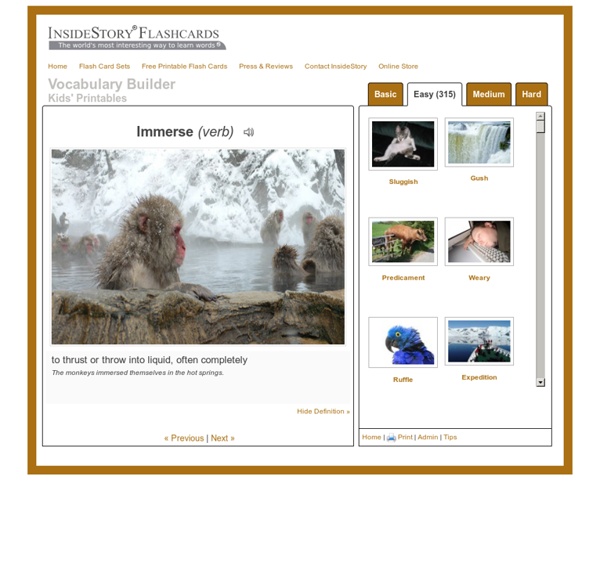How Long to Learn That Language? Here’s a Map for That
For English-speakers, Romanian is easier to learn than German. And you’ll be speaking Russian sooner than Hungarian. How is that? Because the Foreign Service Institute says so.
ESL Kids Puzzles, Printable Crossword and Word Search Puzzles for Children
Download ESL kids puzzles and make your lessons more fun. These puzzles will greatly ease the teaching of spelling, reading, writing, vocabulary and other lexical skills. These worksheets can be used in conjunction with the videos and quizzes of this website. Puzzles are below.
Dictionary.com Flashcards
Master the 1000 most important GRE words with the highest-rated free flashcards for your Android phone. Practice every day to improve your vocab knowledge. Study to rectify your benightedness and prepare to trounce the GRE verbal section! ☞ 1000 vocab words picked by an expert GRE tutor☞ Definitions and example sentences for every word☞ Decks for every difficulty level☞ Track your progress as you study☞ Smart algorithm focuses your practice for efficient learning
Verschlimmbesserung
As Confucius says (Analects 58): "If terms are incorrect, language will be incongruous; and if language be incongruous, deeds will be imperfect... Hence, a man of superior mind, certain of his terms, is fitted to speak; and being certain of what he says can proceed upon it." Awhile back i encountered the German term Verschlimmbesserung--an "improvement" that makes things worse (via BetterThanEnglish dot com). This seems very much of our times, when tamper monkeys not only have seized control of the means of production, they also seem infected with a restlessness entirely disconnected from any awareness of the consequence of their actions. I thought about finding an easier to remember word. Clearly, abprovement & deprovement (rather than simply mux up et al) retain the turn of wit upon the original.
The 60-Second Guide To How Flashcards Actually Work
In the era of digital everything, it’s often easy to lose some of the tried-and-true methods of learning. If you’re like me, you used flashcards a pantload while studying for quizzes, tests, the SATs, etc. But why? Why did you use flashcards? Because, apparently, they work.
Stacks Flashcards
Master the 1000 most important GRE words with the highest-rated free flashcards for your Android phone. Practice every day to improve your vocab knowledge. Study to rectify your benightedness and prepare to trounce the GRE verbal section! ☞ 1000 vocab words picked by an expert GRE tutor☞ Definitions and example sentences for every word☞ Decks for every difficulty level☞ Track your progress as you study☞ Smart algorithm focuses your practice for efficient learning This app gives you free access to all of Magoosh’s GRE flash cards.
Ukindia Learn Sanskrit Lesson 1
Paperhelp to help you write papers Lesson 2 ..Home....Asian Books..Sanskrit lessons ( external)..Tamil.Gujarati. Punjabi.
The Mnemosyne Project
Mnemosyne aims to be a user-friendly flash card program, with a clean, deceptively simple interface that does not require you to wrap your head around complicated concepts before you can start using it. At the same time, under the hood it is very powerful, and its architecture allows infinite extensibility and customisibility through plugins and a scripting API, for the benefit of power users. Here are some screenshots of Mnemosyne in action, illustrating its features.
Dictionary, Thesaurus, and Translations
The main source of TheFreeDictionary's general English dictionary is Houghton Mifflin's premier dictionary, the American Heritage® Dictionary of the English Language, Fifth Edition. This authoritative work is the largest of the American Heritage® dictionaries and contains over 200,000 boldface terms and more than 33,000 written examples. The Fifth Edition also incorporates more than 10,000 new words. Containing 260,000 entries, the general dictionary is augmented with Collins English Dictionary – Complete and Unabridged, and is enhanced by 30,000 illustrations, an audio pronunciation feature, etymologies, abbreviations, biographical entries, and more. Definitions are accompanied by usage examples from classic works of literature, courtesy of The Free Library.



